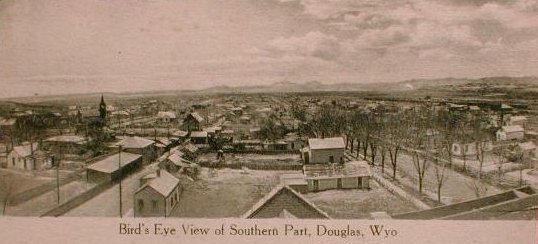
Douglas, Wyoming
Douglas was established in 1886 with the arrival of the railroad. The area,
however, was settled beginning in 1867
with the establishment of Ft. Fetterman,
11 miles north of present day Douglas.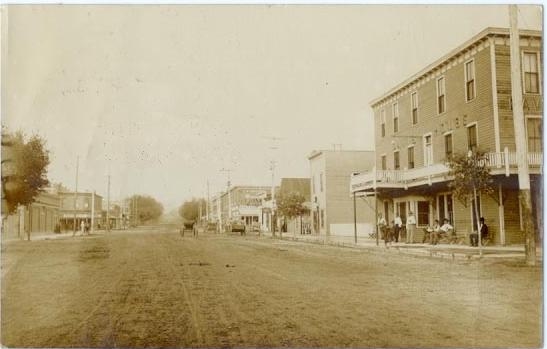
Cedar Street, 1909, Davis House Hotel to left
Lower left, looking North from Oak and 4th, 1911
The fort and the adjacent community
of Fetterman City were
named after Capt. Wm. J. Fetterman, who was killed near Ft. Phil Kearney.
The Fort was always regarded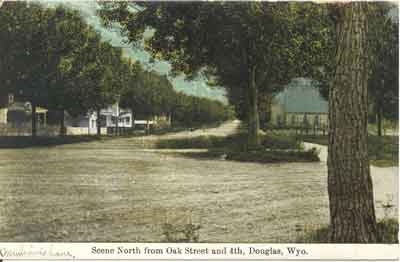 due to lack of amenities and supplies as hardship
duty. Until the arrival of the railroad, supplies had to be brought overland
from either Medicine Bow Station on the Union Pacific or from Ft. Laramie.
The fort was abandoned in 1882. C. H. King, grandfather of Gerald Ford, had a
merchantile establishment in Fetterman City, but moved to Douglas upon the
arrival of the Railroad and Fetterman City was abandoned. King later moved to
Shoshoni where he also operated a merchantile business. The site of his store
in Shoshoni is now occupied by the Yellowstone Drug Store, famous for its real
milkshakes. due to lack of amenities and supplies as hardship
duty. Until the arrival of the railroad, supplies had to be brought overland
from either Medicine Bow Station on the Union Pacific or from Ft. Laramie.
The fort was abandoned in 1882. C. H. King, grandfather of Gerald Ford, had a
merchantile establishment in Fetterman City, but moved to Douglas upon the
arrival of the Railroad and Fetterman City was abandoned. King later moved to
Shoshoni where he also operated a merchantile business. The site of his store
in Shoshoni is now occupied by the Yellowstone Drug Store, famous for its real
milkshakes. Fetterman City was also the site of the Fetterman Hospital Association,
an early form of a health maintenance organization. Cowboys, working for some of
the large ranches, could belong by having a small sum deducted from their pay,
and be guaranteed health care for anything except certain social ailments.
 In 1886, the Chicago, and Northwestern reached Douglas, photo below, built across
the river from the site of Ft. Fetterman. In the Douglas Park Cemetary lie the
remains of James M. "Doc Middleton" Riley, who begain his career as a horse-thief
and murderer at age 14 and George Pike, rustler: In 1886, the Chicago, and Northwestern reached Douglas, photo below, built across
the river from the site of Ft. Fetterman. In the Douglas Park Cemetary lie the
remains of James M. "Doc Middleton" Riley, who begain his career as a horse-thief
and murderer at age 14 and George Pike, rustler:
Underneath this stone in eternal rest
Sleeps the wildest one of the wayward west
He was a gambler and sport and cowboy too
And he led the pace in an outlaw crew
He was sure on the trigger and staid to the end
But he was never known to quit on a friend
In the relations of death all men are alike
But in life there was only one George W. Pike
Riley was reputed to have stolen 2,000 horses from ranchers and the Sioux in one
two-year period and was, reputedly, associated with Kid Wad who ended this mortal
coil as the guest of
honor at a necktie party in Bassett, Neb. Pike, in contrast, supposedly died of
a heart attack after winning a large hand in a poker game in a local saloon.
Since it is impolite to quit when ahead, the remaining players decided that if
George could speak for himself he would have stayed to the end, he would
not quit on a friend and the game should continue. George was propped up and a bystander was requested
to continuing playing George's hands. George's winning streak continued and
allegedly he won enough to go off in grand style and pay for the tombstone pictured above right. In some
sense, one can perhaps see a rather punny allusion in the epitaph to how George played out life's last hand.
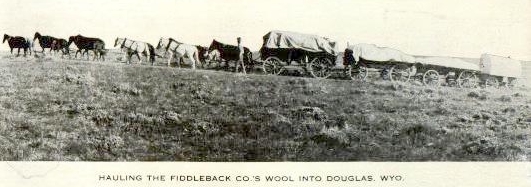
Hauling wool from the Fiddleback Ranch to Douglas
Below left, 3rd Street looking north, 1920's
The Fiddleback Ranch, north of Douglas on the Cheyenne, was owned by Ephrain Tillotson.
Tillotson,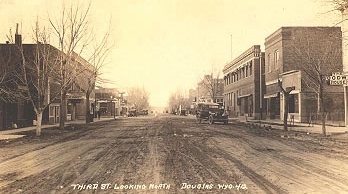 among other things donated the original
building for the Hospital
Association. The Association when it was formed, employed Amos Barber as its
physician at a salary of $100.00 per month and paid his moving expenses to Wyoming.
Contrary to some assertions, Dr. Barber did not come to the Territory
with the
military, although he subsequently did serve in the Southwest and in the Spanish-American War.
In 1889 the Association was discontinued and Dr. Barber went into private practice
in Douglas. With statehood, Dr. Barber became the first Secretary of State.
With the election of Gov. Francis E. Warren to the Senate, Dr. Barber became
Acting Governor and was so serving at the time of the Johnson County War.
Both the hospital and Dr. Barber are mentioned in Owen Wister's stories of
Wyoming, although he refers to Fetterman City as "Dry Bone." After
Tillotson's death at the turn of the century, the Fiddleback was sold to a corporation
headed by Roscoe Crary, a principal of Texaco. among other things donated the original
building for the Hospital
Association. The Association when it was formed, employed Amos Barber as its
physician at a salary of $100.00 per month and paid his moving expenses to Wyoming.
Contrary to some assertions, Dr. Barber did not come to the Territory
with the
military, although he subsequently did serve in the Southwest and in the Spanish-American War.
In 1889 the Association was discontinued and Dr. Barber went into private practice
in Douglas. With statehood, Dr. Barber became the first Secretary of State.
With the election of Gov. Francis E. Warren to the Senate, Dr. Barber became
Acting Governor and was so serving at the time of the Johnson County War.
Both the hospital and Dr. Barber are mentioned in Owen Wister's stories of
Wyoming, although he refers to Fetterman City as "Dry Bone." After
Tillotson's death at the turn of the century, the Fiddleback was sold to a corporation
headed by Roscoe Crary, a principal of Texaco.
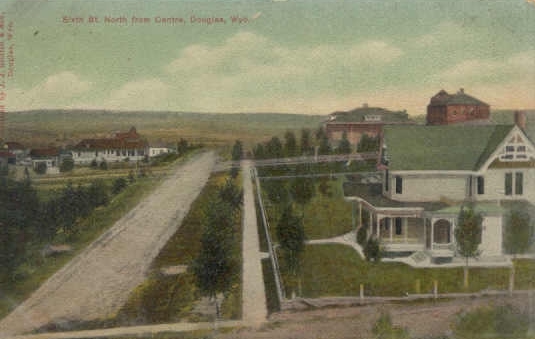 Douglas, 6th Street, looking north from Center
Douglas, 6th Street, looking north from Center
|